Esala:
The season of Peraheras
It is now Esala in the Sinhala calendar, and the season of peraheras
in Sri Lanka. Before the drumming stops at one venue it is taken up at
another.
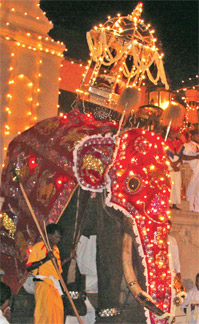 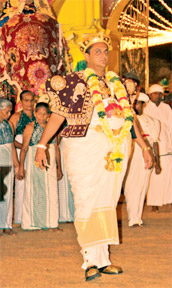 The
cycle of peraheras which begins at the Kataragama Devala the week before
the Esala Full Moon Poya continues throughout the months of Esala,
Nikini, Binara (July, August, September) and ends with the Kotte
Perahera in the city of Sri Jayewardenepura. The
cycle of peraheras which begins at the Kataragama Devala the week before
the Esala Full Moon Poya continues throughout the months of Esala,
Nikini, Binara (July, August, September) and ends with the Kotte
Perahera in the city of Sri Jayewardenepura.
Kandy’s Esala Perahera, the grandest and best known perahera follows
the Aluthnuwara Perahera. Aluthnuwara is a small village in the Kegalle
district and its claim to fame is the devala dedicated to God Dedimunda
(Dedimunda Deviyo) invoked by devotees for help in times of trouble or
to grant their wishes.
The Esala Perahera in Kandy is followed by the Saman Devala Perahera
in Ratnapura, Dodanwela Devala Hanguranketha and Embekke peraheras and
lastly the Saman Devala perahera in Mahiyangana. A special feature of
this last perahera is the participation of the Aadivasi (Vedda)
community in a separate perahera. And, this cycle of peraheras, coming
down from the times of the Sinhala kings, comes to a close at
Mahiyangana.
Many lesser known Esala Peraheras have come down from the time of the
Kandyan Kingdom. Among them are the perahera at Badulla, Kuda Kataragama
perahera at Amunugoda (7 km from Godakawela) and the Sankhapala Vihara
perahera (Ratnapura district) also in honour of God Kataragama.
In the low country, the Devinuwara Sri Vishnu Devala festival and
perahera comes after the Kataragama perahera with its finale at the next
full moon(Nikini). Another old festival and perahera coming down the
centuries is the one at Munneswaram. This devala is dedicated to God
Ishvara.
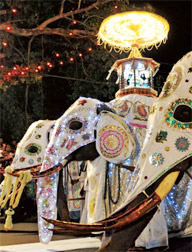 Of
the Esala Perahera of recent origin, the oldest is the Kotte Perahera
started in 1901 or 1902. The Bellanvila Perahera was started 50 years
later in 1950. The Dalada Perahera of Wadduwa goes back to 1924.
Seenigama Esala perahera, is I was told, less then 40 years old. These
are only a few of the many peraheras in Esala, started in the last
century. Of
the Esala Perahera of recent origin, the oldest is the Kotte Perahera
started in 1901 or 1902. The Bellanvila Perahera was started 50 years
later in 1950. The Dalada Perahera of Wadduwa goes back to 1924.
Seenigama Esala perahera, is I was told, less then 40 years old. These
are only a few of the many peraheras in Esala, started in the last
century.
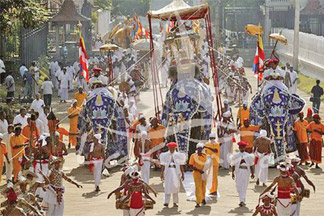 The
old Esala peraheras including the Kandy Perahera is the finale to the
Esala pooja or rites of Esala at a devala dedicated to a god. It is
well-known that the Dalada Perahera was added to the four devale
peraheras held in honour of gods Natha, Vishnu, Kataragama and Pattini
on the suggestion of Ven. Upali Thera, the Thai bhikkhu who had come to
confer ‘upasampada (higher ordination) on the Sinhala bhikkhus. The
old Esala peraheras including the Kandy Perahera is the finale to the
Esala pooja or rites of Esala at a devala dedicated to a god. It is
well-known that the Dalada Perahera was added to the four devale
peraheras held in honour of gods Natha, Vishnu, Kataragama and Pattini
on the suggestion of Ven. Upali Thera, the Thai bhikkhu who had come to
confer ‘upasampada (higher ordination) on the Sinhala bhikkhus.
The ‘Satara devala perahera,’ was part of the Esala Mangallaya, one
of the four important festivals in the Kingdom of the Sinhala Kings.
Robert Knox who was kept a prisoner by King Rajasingha II from
1660-1679, saw this perahera, and his account is the earliest account we
have of this perahera. Knox says, Every year in the monts of June-July
at a new moon, they observe a solemn festival called perahera in the
city of Cande, at the same time there are peraheras in other towns.’
This is done, says Knox ‘to honour these gods and get their aid and
assistance.’
 The
peraheras of recent origin those started in the last century like Kotte
and Bellanwila peraheras are not connected with a devala, and a special
Esala pooja like the Devinuwara Ratnapura on Mahiyangana peraheras. The
peraheras of recent origin those started in the last century like Kotte
and Bellanwila peraheras are not connected with a devala, and a special
Esala pooja like the Devinuwara Ratnapura on Mahiyangana peraheras.
The Wadduwa Dalada Perahera, conducted by the Daladawatta vihara is a
perahera in honour of the Dalada. During the times when the Portuguese
were controlling the low country and from time to time invading the
kingdom in the hill country, the Dalada (the Sacred Tooth Relic) was
taken from place to place for safety. Wadduwa is one place where it was
kept hidden and that site became known as Daladawatta.
It is festival time in the North too. Nallur Kovil festival in honour
of God Skanda (God Kataragama) is one of, if not the grandest, Esala
festival in Sri Lanka. It goes on for 25 days, and the last three
nights, when the chariot with the insignia is taken along the streets,
is the culmination of the festival. After the final perahera the
festival closes with the water-cutting ceremony.
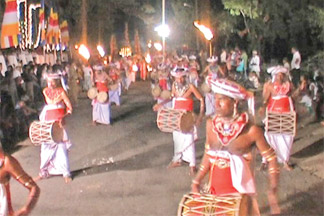 Colombo
too has its own Esala festival and perahera; the Vel Festival in August
in honour of God Kathiresan. This is a very old festival going back a
century or so. Colombo
too has its own Esala festival and perahera; the Vel Festival in August
in honour of God Kathiresan. This is a very old festival going back a
century or so.
The Vel-that is the insignia of the God is brought in a procession
from the temple in Sea Street in Pettah, to the Kathiresan Kovil in
Bambalapitiya. It is a daytime procession. At the Bambalapitiya kovil,
poojas (rites) are done for a few days, with the participation of Tamil
and Sinhala devotees.
At the close of the festival the Vel is taken back in a procession to
Sea Street. The procession leaves Bambalapitiya late evening and as
darkness descends it is a grand and colourful spectacle. Crowds line
Galle Road all the way. It is nearly midnight when the procession
reaches Galle Face.
Why is Esala the season of festivals and peraheras? It is not that
this is the best time of the year, when the clear weather is just right
for processions. Esala was a time of feasting and festivity in the
Ganges plain even before the time of the Buddha. Buddhist literature has
accounts of Esala celebrations the year before the birth of Prince
Siddhartha. His renunciation of worldly life was also on an Esala Full
Moon Poya Day, when all Kapilavastu was in festive mood. There was
dancing and singing in the palace, but Prince Siddhartha was bored, and
he stealthily left the palace that night.
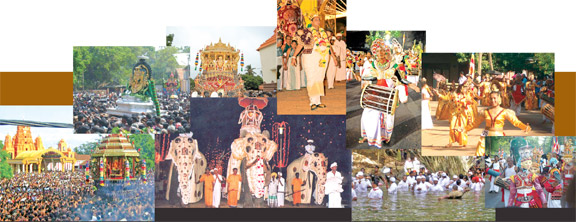
Esala was a carnival time in north India in the 5th century BC. It
was just before the monsoon began. It was like the carnival time in
Europe and South America before Lent. It was the last fling before the
lashing rains forced people to keep indoors. That is why the ‘Vas’
period when Buddhist monks stay in one place, starts on Esala Full Moon
Poya Day.
Climatic changes are different in Sri Lanka, 14 degrees South of the
Ganges plain. But the same customs, rites and festivals are observed at
Esala even though it is not the time before the monsoon.
- Sumana Saparamadu
|

